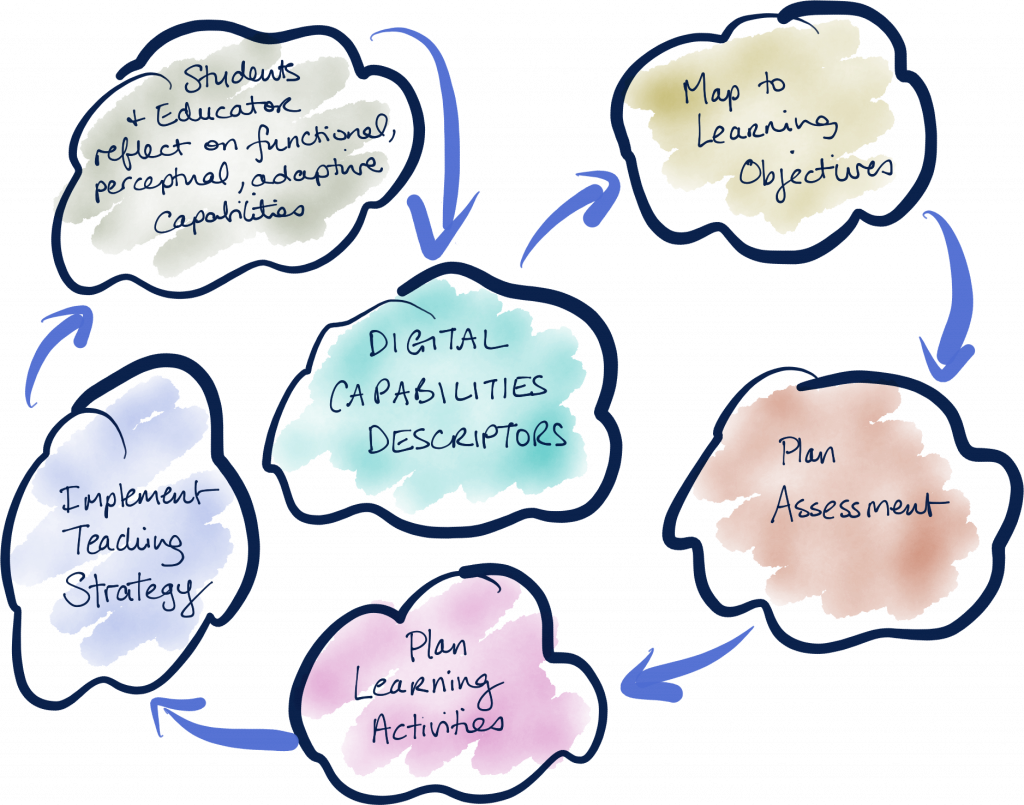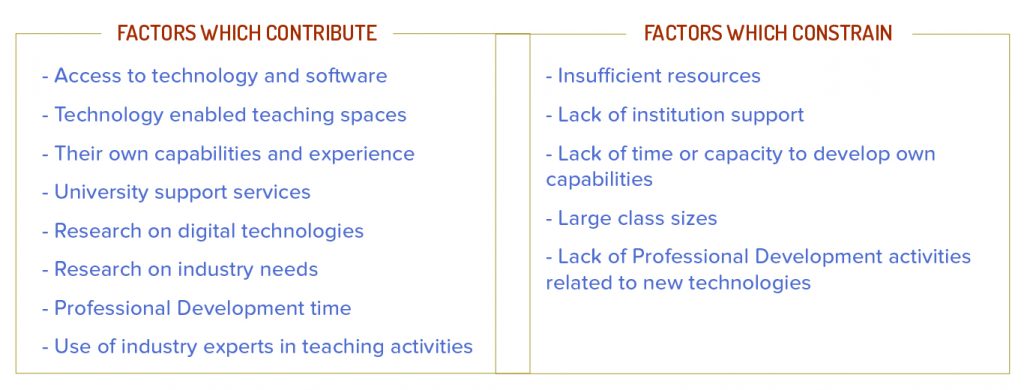Workshop Part 3: Using the Learning Model in Your Teaching
AIM:
- Develop ideas for how to apply the learning model to your curriculum and lesson planning
- Apply digital descriptors to adapt or create Subject Learning Objectives (SLOs)
- Explore ideas for assessing digital capabilities
- Discuss strategies to implement the learning model in your current practice
Tip: Ask participants to bring along their Subject Outlines with Subject Learning Objectives to the workshop.
NB clarification of terms may be needed – some universities use the term ‘Unit’ or “Course’ rather than ‘Subject’ and use the term Course Learning ‘Outcomes’ rather than ‘Objectives’.
suggested content structure:
3.1. Provide an overview of the ways the learning model can be used in teaching.
For example, the Digital Capabilities Descriptors can be used in different ways, such as:
- guiding the design of assessment and learning activities to enhance existing curriculum
- guiding new program and course/unit development
- guiding teaching plans focused on particular technology
Note that the three layers of Functional, Perceptual and Adaptive are hierarchical but integrated. It is vital that students are encouraged to reflect on and discuss the scaffold in relation to their own digital capabilities and practices for work futures.
Illustrate this iterative process with the Digital Affordance Developmental Learning Model in action:
Figure 5: Digital Affordance Developmental Learning Model in Action
3.2. Practise applying digital descriptors to adapt or create Subject Learning Objectives/Outcomes (SLOs)
If participants haven’t already identified the digital descriptors relevant to their subject (Topic 2 above), ask them to look over the list of domains. Choose 1-3 relevant domains and read over their digital capability descriptors.
Ask them to review their Subject Learning Objectives/Outcomes individually and identify Descriptors that are a good fit and could be incorporated in learning activities/assessment.
Participants share and discuss the process of mapping Objectives/Outcomes to Descriptors.
3.3. Develop ideas for assessing digital capabilities
- Show examples of how the project subjects assessed digital capabilities.
- See the examples of assessment questions on the website
- Participants to choose one domain.
- Group together participants who have chosen the same or similar domains.
- With participants in their domain groups, brainstorm ways to assess functional and perceptual affordances – that is in known contexts. (This may require first identifying what are known contexts relevant to their subject.)
- Then still in domain groups, participants to brainstorm ways to assess adaptive capability.
- Participants to share back ideas with the rest of the workshop group.
Discussion prompts: stage of learning, learning outcomes required, time available, industry partners required, resources needed and possible.
3.4. Workshop ways to apply the learning model to curriculum and lesson planning
- Show example/s of using the learning model in teaching. Case studies can be found on the Teaching Resources page.
- Discussion prompt: What are ways that you could apply the learning model to curriculum and lesson planning?
- Activity: Apply the learning model to curriculum and lesson planning
- With participants still in their domain groups, participants to brainstorm ways that they can support their students developing that domain on a functional, perceptual and adaptive level.
- Participants share their group’s ideas back with the rest of the workshop group.
You can also prompt educators to consider and discuss:
- What are ways that you build in reflection with your students during and after learning activities?
- Are there ‘wicked problem’ projects students could work on across disciplines to help develop their Perceptual and Adaptive digital capabilities?
3.5. Discuss next steps and implementation
Go through factors that shape our capacity to support learners in developing digital capabilities – these emerged through the project educator survey:
Discussion prompts:
- How does your current situation support learners in developing digital capabilities?
- How does your current situation constrain learners in developing digital capabilities?
- What is the first thing you would need to do, to make the model work for you with your students?
Consider ending the workshop with each educator choosing what is the next step they could take to implement the model in their teaching.
Workshop Resources:
Handouts:
Further Resources:

